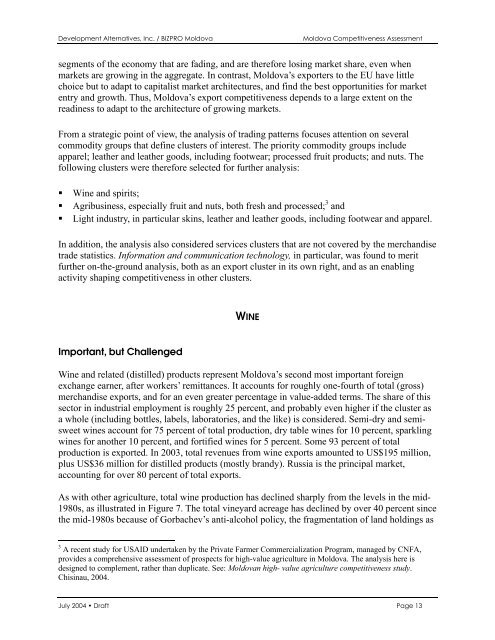Assessing Competitiveness In Moldova's Economy - Economic Growth
Assessing Competitiveness In Moldova's Economy - Economic Growth
Assessing Competitiveness In Moldova's Economy - Economic Growth
Create successful ePaper yourself
Turn your PDF publications into a flip-book with our unique Google optimized e-Paper software.
Development Alternatives, <strong>In</strong>c. / BIZPRO Moldova Moldova <strong>Competitiveness</strong> Assessment<br />
segments of the economy that are fading, and are therefore losing market share, even when<br />
markets are growing in the aggregate. <strong>In</strong> contrast, Moldova’s exporters to the EU have little<br />
choice but to adapt to capitalist market architectures, and find the best opportunities for market<br />
entry and growth. Thus, Moldova’s export competitiveness depends to a large extent on the<br />
readiness to adapt to the architecture of growing markets.<br />
From a strategic point of view, the analysis of trading patterns focuses attention on several<br />
commodity groups that define clusters of interest. The priority commodity groups include<br />
apparel; leather and leather goods, including footwear; processed fruit products; and nuts. The<br />
following clusters were therefore selected for further analysis:<br />
Wine and spirits;<br />
Agribusiness, especially fruit and nuts, both fresh and processed; 3 and<br />
Light industry, in particular skins, leather and leather goods, including footwear and apparel.<br />
<strong>In</strong> addition, the analysis also considered services clusters that are not covered by the merchandise<br />
trade statistics. <strong>In</strong>formation and communication technology, in particular, was found to merit<br />
further on-the-ground analysis, both as an export cluster in its own right, and as an enabling<br />
activity shaping competitiveness in other clusters.<br />
Important, but Challenged<br />
WINE<br />
Wine and related (distilled) products represent Moldova’s second most important foreign<br />
exchange earner, after workers’ remittances. It accounts for roughly one-fourth of total (gross)<br />
merchandise exports, and for an even greater percentage in value-added terms. The share of this<br />
sector in industrial employment is roughly 25 percent, and probably even higher if the cluster as<br />
a whole (including bottles, labels, laboratories, and the like) is considered. Semi-dry and semisweet<br />
wines account for 75 percent of total production, dry table wines for 10 percent, sparkling<br />
wines for another 10 percent, and fortified wines for 5 percent. Some 93 percent of total<br />
production is exported. <strong>In</strong> 2003, total revenues from wine exports amounted to US$195 million,<br />
plus US$36 million for distilled products (mostly brandy). Russia is the principal market,<br />
accounting for over 80 percent of total exports.<br />
As with other agriculture, total wine production has declined sharply from the levels in the mid-<br />
1980s, as illustrated in Figure 7. The total vineyard acreage has declined by over 40 percent since<br />
the mid-1980s because of Gorbachev’s anti-alcohol policy, the fragmentation of land holdings as<br />
3 A recent study for USAID undertaken by the Private Farmer Commercialization Program, managed by CNFA,<br />
provides a comprehensive assessment of prospects for high-value agriculture in Moldova. The analysis here is<br />
designed to complement, rather than duplicate. See: Moldovan high- value agriculture competitiveness study.<br />
Chisinau, 2004.<br />
July 2004 • Draft Page 13
















